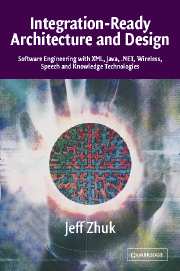 Integration-Ready Architecture and Design
Integration-Ready Architecture and Design Book contents
- Frontmatter
- Contents
- Preface
- Contributors
- Acknowledgments
- Introduction
- Notes for Educators: AMA Teaching Methods
- Chapter 1 Collaborative Engineering
- Chapter 2 Software Architecture and Integration Technologies
- Chapter 3 From a Specific Task to “Integration-Ready” Components
- Chapter 4 Integration with Voice
- Chapter 5 An Introduction to Knowledge Technologies
- Chapter 6 Write Once
- Chapter 7 The New Generation of Client–Server Software
- Chapter 8 Wireless Technologies
- Chapter 9 Programming Wireless Application Protocol Applications
- Chapter 10 A Single JavaCard Identity Key for All Doors and Services
- Chapter 11 The J2ME Family
- Chapter 12 Speech Technologies on the Way to a Natural User Interface
- Chapter 13 Integration with Knowledge
- Chapter 14 Distributed Life in the JXTA and Jini Communities
- Appendix 1 Java and C#: A Saga of Siblings
- Appendix 2 XML and Web Services
- Appendix 3 Source Examples
- Index
Appendix 3 - Source Examples
Published online by Cambridge University Press: 17 August 2009
- Frontmatter
- Contents
- Preface
- Contributors
- Acknowledgments
- Introduction
- Notes for Educators: AMA Teaching Methods
- Chapter 1 Collaborative Engineering
- Chapter 2 Software Architecture and Integration Technologies
- Chapter 3 From a Specific Task to “Integration-Ready” Components
- Chapter 4 Integration with Voice
- Chapter 5 An Introduction to Knowledge Technologies
- Chapter 6 Write Once
- Chapter 7 The New Generation of Client–Server Software
- Chapter 8 Wireless Technologies
- Chapter 9 Programming Wireless Application Protocol Applications
- Chapter 10 A Single JavaCard Identity Key for All Doors and Services
- Chapter 11 The J2ME Family
- Chapter 12 Speech Technologies on the Way to a Natural User Interface
- Chapter 13 Integration with Knowledge
- Chapter 14 Distributed Life in the JXTA and Jini Communities
- Appendix 1 Java and C#: A Saga of Siblings
- Appendix 2 XML and Web Services
- Appendix 3 Source Examples
- Index
Summary
In this appendix, you will find practical examples of how to:
Start a collaborative service
Read/write geographical data
Use Java Naming and Directory Interface (JNDI) for multiple types of data sources, including domain name servers
Share a screen with multiple users (great for troubleshooting and demos!)
Use Java Media Framework (JMF) and Java Message Service (JMS)
Create speech recognition and text-to-speech (TTS) applications in C#
Spam and Spam Killers
Improving efficiency and reliability of your email server
Create a distributed knowledge systema and join educational/knowledge alliances.
These are the main targets, but the list can go on and on. You will find basic source examples in this appendix, and you can download more from this book's support Web sites at Cambridge University Press (www.cup.org/titles/ 0521525837.htm) and ITSchool, Inc.(www.JavaSchool.com).
GETTING INTO COLLABORATIVE SERVICES
Ben was always good with computers; some cosmic adventure games even followed him in his dreams. He was also very open to sharing or (using the impressive word) “collaboration.” He opened his first collaborative Web site when he was very young. He often had to stay home sick, and the site helped him to keep in touch with his kindergarten class. All his teachers and friends received his invitation-links to the site, except for Peter, a boy who never shared his piece of cake with anyone.
- Type
- Chapter
- Information
- Integration-Ready Architecture and DesignSoftware Engineering with XML, Java, .NET, Wireless, Speech, and Knowledge Technologies, pp. 551 - 598Publisher: Cambridge University PressPrint publication year: 2004
